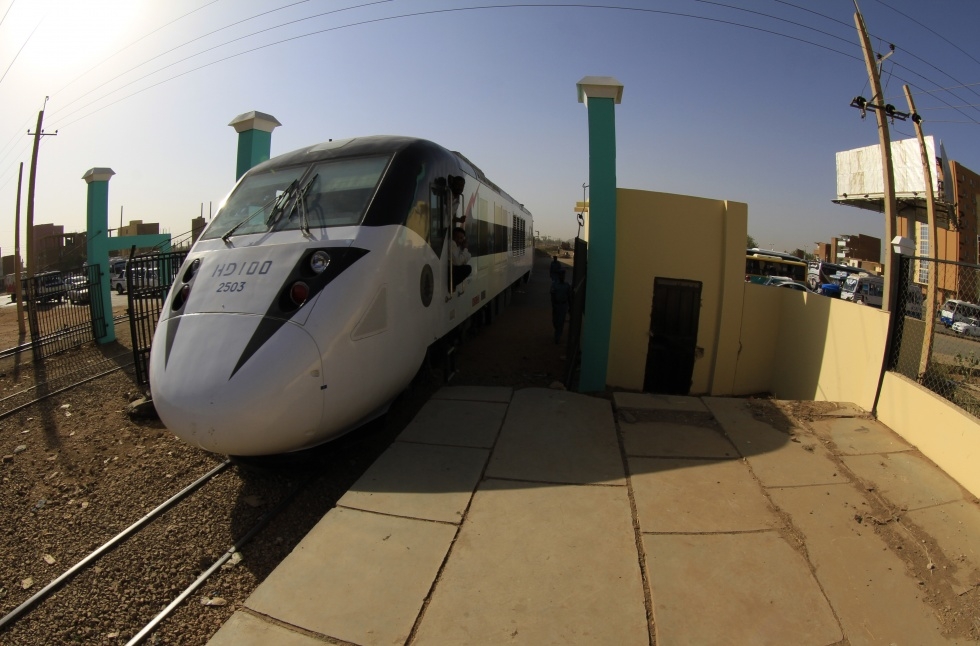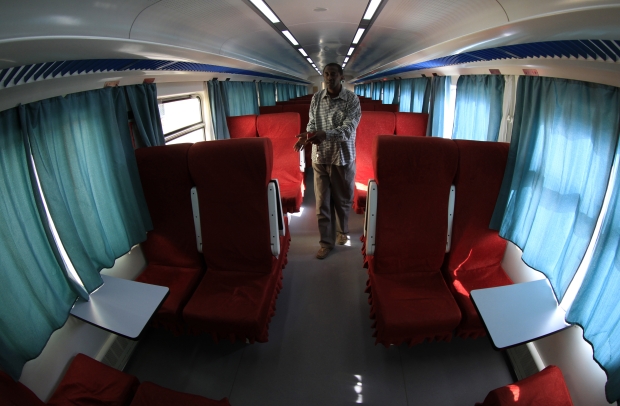Sudan's new sharp-nosed train a rarity

By Ian Timberlake
KHARTOUM - In a dilapidated, poverty-stricken country where some railway rolling stock is more than 40 years old, Sudan's sleek, sharp-nosed Nile Train is an unusual sight.
From a distance it looks like a large white snake gliding past fields of green near the Nile River north of Khartoum.
On January 20 the train began daily passenger service -- Sudan's first in years -- as part of efforts to revive the railway system despite an economic crisis that has left the country ravaged by inflation and starving for hard currency.
"This new train is really, really modern," says Ahmed Hussein, the project manager for Sudan Railways Corporation.
New MEE newsletter: Jerusalem Dispatch
Sign up to get the latest insights and analysis on Israel-Palestine, alongside Turkey Unpacked and other MEE newsletters
The four coaches roll out of the once-abandoned station in an industrial area of North Khartoum at 9:00 am every day, heading north with two stops before reaching the railway junction town of Atbara.
The journey of close to 300 kilometres (186 miles) takes six hours and 40 minutes. That is roughly twice as long as a bus but a lot quicker than the old trains serving Sudan's other passenger rail destinations -- all two of them.
The train to Nyala, in war-torn Darfur, goes every two weeks, while another makes a weekly trip north of Atbara to Wadi Halfa near the Egyptian border.
Even though track conditions have restricted speeds of the Nile Train, it has proven so popular that in March the railway doubled its frequency to twice daily in the corridor which is already heavily-travelled by buses, transport trucks and private cars.
Hussein said every Nile Train service is almost full with an average passenger load of around 284.
Sudan bought two of the trains from China at a total cost of around $13 million, which is being paid over about four years, he said.
Safer than the bus
"I think most people travelling between Khartoum and Atbara will stop using buses and change to this new train," said Hannah Ali Mohammed, 35, marvelling at how, unlike older trains, the air-conditioned coaches kept her clothes free of desert dust during the trip to North Khartoum.
A student, Ahmed Al-Haj Omer, 23, said it was his first time riding the rails.
"I enjoyed it," he said. "It's safer. There are a lot of bus accidents on the road between Khartoum and Atbara."
A bus ticket also costs about 50 percent more than the 51-pound ($6) train trip.
Hassan Abdulmajid, 52, said he has already used the Nile Train four times and hopes other parts of the country will get a similar service.
That is the plan, says Hussein, but the first obstacle to overcome is the track.
"Unfortunately, we have only one track," meaning freight and passenger services share the same narrow-gauge rails, although the company is doing its best to upgrade what they have, he said.
Sudanese and Chinese firms have been replacing wooden railway ties with concrete on the Khartoum-Atbara line, while track work has also started between Atbara and the trade centre of Port Sudan, he said.
Rehabilitation of the line to Wad Medani, in Sudan's once-thriving agricultural heartland, will follow soon, Hussein said.
After that, service by modern coaches like the Nile Train can be expanded.
This was part of former general manager Makawi Mohammed Awad's vision for restoring the railway, employees say.
In December, Awad was named to the cabinet where he is minister of oil.
The Khartoum-Atbara route formed part of the main line to Port Sudan and dates from 1898, the year before Britain and Egypt began to jointly administer Sudan, the railway's website says.
"It played a very important role in unifying the country," said veteran newspaper columnist Mahjoub Mohamed Salih, who hasn't used the railway in about 30 years.
An efficient rail system would be an asset for the country which has been desperate for hard currency since the loss of about 75 percent of its oil production when South Sudan separated in 2011.
"It will remain that railways are the cheapest system for your exports," Salih said.
A railway morgue
Khartoum has been under a United States trade embargo since 1997, and Mohamed Oro Saliem Mohamed, the railway's locomotive and rolling stock manager, says all of Sudan's American-made engines are idle because of a parts shortage.
Others are still able to pull 20-25 freight trains around the country daily, he says, adding with a slight chuckle that some are very old.
"Some of them, 1970. Some of them, 1960... but rehabilitated."
Many of the roughly 49 functional locomotives have been purchased in recent years from China, and five more are on the way, Mohamed says.
Decaying grey and yellow coaches from decades past lie abandoned behind his central Khartoum railway headquarters.
It is a railway morgue, but alongside the corpses are signs of life.
In recent months a new dirt road has been built into the site where pedestrians used to wander freely. A fence has gone up, and Sudanese workers hammer away at severed pieces of track. A backhoe digs, and a Chinese technician has set up his surveying tool on a tripod.
Train horns are heard more frequently in the city.
For newspaper columnist Salih the Nile Train and accompanying improvements are a small step "but not much".
"I think the collapse of Sudan Railways is total, and partial rehabilitation will not do," he said.
"But they have to start somewhere."
Middle East Eye delivers independent and unrivalled coverage and analysis of the Middle East, North Africa and beyond. To learn more about republishing this content and the associated fees, please fill out this form. More about MEE can be found here.


